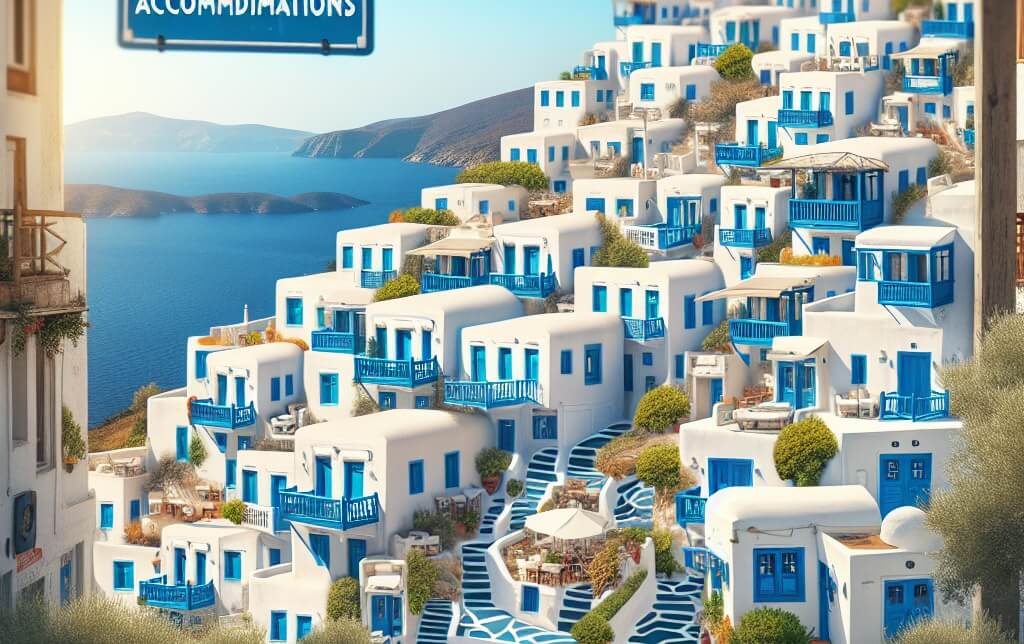
Modern Greece Houses Design: Inspiring Architecture Ideas
Modern Greece houses design showcases a blend of traditional architectural elements with contemporary influences, resulting in inspiring and unique architecture ideas. From the iconic white-washed buildings with blue accents in Santorini to the elegant stone houses in the Peloponnese region, Greek architecture is renowned for its simplicity, elegance, and functionality. The use of natural materials such as stone, wood, and marble, along with a focus on outdoor living spaces that connect seamlessly with the surrounding landscape, exemplifies the Greek design aesthetic. Incorporating elements such as arched doorways, terracotta roofs, and intricate mosaic patterns, modern Greek houses embody a timeless charm that continues to captivate and inspire designers and homeowners alike.
I. Introduction
In the realm of architecture and design, the houses of greece stand as iconic representations of a rich cultural heritage and timeless aesthetic appeal. The unique characteristics of Greek house design embody a fusion of traditional elements with modern influences, resulting in structures that exude elegance and functionality. From the whitewashed facades and blue accents of the Cycladic islands to the intricate mosaics and columns of ancient Greek architecture, each house in Greece tells a story of artistry and craftsmanship. This exploration of Greece's housing design will delve into the key features, influences, and significance of these architectural marvels, shedding light on the enduring allure of Greek homes.
- Brief overview of Greece houses design
Greek house design is characterized by its unique blend of history, culture, and natural surroundings. Traditional Greek houses often feature white-washed walls and blue accents, reflecting the colors of the sea and sky. The architecture typically includes flat roofs, thick walls for insulation against the Mediterranean climate, and open courtyards or verandas to promote outdoor living. In rural areas, stone houses with wooden shutters and tiled roofs are common, while in urban centers, neoclassical influences can be seen in the grand facades and ornate detailing. Overall, Greek house design embodies a harmonious relationship with the landscape and a timeless aesthetic that has endured for centuries.
- Importance of Greek architecture and aesthetics
Greek architecture and aesthetics hold immense importance in the realm of design, particularly in the context of Greece's housing structures. The architectural principles and design elements developed by the ancient Greeks have significantly influenced and shaped the way we perceive and create buildings today. The emphasis on proportion, harmony, and balance in Greek architecture has served as a cornerstone for architectural practices across the globe. The use of columns, architraves, and pediments in Greek buildings not only provided structural support but also added a sense of grandeur and elegance to the overall design. Additionally, the aesthetic beauty of Greek architecture, with its intricate detailing and sculptural decorations, continues to inspire and captivate designers and architects, showcasing the enduring significance of Greek design principles in the field of housing and beyond.
II. Greek Architecture
Greek architecture is characterized by its emphasis on symmetry, proportion, and balance. The design of Greek houses reflects these principles, with structures typically featuring columns, pediments, and entablatures. The use of materials such as limestone, marble, and terracotta further enhances the aesthetic appeal of Greek homes. The layout of Greek houses often includes a central courtyard, surrounded by rooms that open up to the outdoors. This design not only provides natural light and ventilation but also creates a sense of harmony with the surrounding environment. Overall, Greek architecture in the context of housing design showcases a meticulous attention to detail and a reverence for classical ideals of beauty and order.
- Characteristics of traditional Greek architecture
Traditional Greek architecture is characterized by a number of distinct features that have become iconic symbols of the country's rich cultural heritage. One of the most notable characteristics is the use of columns, particularly the Doric, Ionic, and Corinthian styles, which are often seen in the design of temples and public buildings. These columns are typically fluted and topped with intricately carved capitals, adding a sense of grandeur and elegance to the structures. Additionally, Greek houses are often characterized by their simple geometric shapes, white plastered walls, and red-tiled roofs, reflecting the influence of the Mediterranean climate on architectural design. The use of natural materials such as stone and marble further enhances the timeless beauty and durability of traditional Greek architecture.
- Influence of ancient Greek architecture on modern designs
The influence of ancient Greek architecture on modern designs, particularly in the context of Greece house design, is profound and enduring. The architectural elements and principles established by the ancient Greeks, such as the use of columns, symmetry, and proportion, continue to inspire contemporary architects and designers. The iconic Doric, Ionic, and Corinthian columns, for example, are frequently incorporated into modern residential structures, lending a sense of grandeur and timelessness. Additionally, the emphasis on harmony and balance in ancient Greek architecture can be seen in the clean lines and well-balanced proportions of many modern Greek-inspired homes. Overall, the legacy of ancient Greek architecture persists in the realm of modern design, serving as a timeless source of inspiration and influence.
- Use of columns, pediments, and friezes
In the context of Greek house design, the use of columns, pediments, and friezes is a defining characteristic that reflects the architectural influence of ancient Greek culture. Columns, particularly the iconic Doric, Ionic, and Corinthian orders, are not merely structural elements but also symbols of strength, beauty, and order. Pediments, typically found at the top of the façade, add a sense of grandeur and symmetry to the overall design. Friezes, often decorated with intricate patterns or reliefs, serve as ornamental bands that enhance the visual appeal of the building. Together, these elements contribute to the timeless elegance and classical aesthetic of Greek architecture, showcasing a harmonious blend of form and function.
- Integration of natural elements in design
The integration of natural elements in the design of Greek houses is a fundamental aspect that reflects the country's rich cultural heritage and harmonious relationship with the environment. Traditional Greek architecture often incorporates elements such as stone, wood, and clay, which not only blend seamlessly with the natural surroundings but also provide sustainable and durable construction materials. The use of these natural elements not only enhances the aesthetic appeal of the houses but also ensures that they remain cool during the hot summers and warm during the colder months, showcasing a deep understanding of climate-responsive design. Additionally, the incorporation of elements such as courtyards, terraces, and gardens further connects the inhabitants with nature, promoting a sense of tranquility and well-being. Overall, the integration of natural elements in the design of Greek houses exemplifies a timeless and holistic approach to architecture that prioritizes sustainability, functionality, and aesthetic beauty.
III. Greek Aesthetic
The Greek aesthetic in the context of Greece house design is characterized by a focus on balance, harmony, and simplicity. This aesthetic draws inspiration from ancient Greek architecture, with an emphasis on clean lines, geometric shapes, and a sense of proportion. Greek houses often feature elements such as columns, pediments, and symmetrical facades, reflecting the classical ideals of beauty and order. The use of natural materials such as stone, wood, and clay further enhances the connection to the surrounding landscape. Overall, the Greek aesthetic in house design embodies a timeless elegance that continues to influence architectural styles around the world.
- Focus on simplicity, harmony, and balance
When designing Greek houses, it is essential to focus on simplicity, harmony, and balance. These principles are deeply rooted in Greek architecture and play a significant role in creating a cohesive and aesthetically pleasing design. By embracing simplicity, one can achieve a sense of elegance and timelessness in the overall look of the house. Harmony ensures that all elements of the design work together seamlessly, creating a unified and coherent aesthetic. Finally, balance helps to distribute visual weight evenly throughout the design, creating a sense of equilibrium and tranquility. By prioritizing these principles in the design process, one can create Greek houses that exude a sense of beauty and sophistication.
- Use of white and earthy tones
In designing Greek houses, the utilization of white and earthy tones plays a significant role in capturing the essence of traditional Greek architecture. The choice of white reflects the characteristic whitewashed buildings found throughout Greece, symbolizing purity, simplicity, and a connection to the Mediterranean landscape. Earthy tones, such as terracotta, ochre, and olive green, are reminiscent of the natural elements present in the Greek environment, blending harmoniously with the surrounding scenery. This color palette not only enhances the aesthetic appeal of Greek houses but also serves to create a sense of unity with the traditional architectural style of the region, embodying a timeless and elegant design aesthetic.
- Incorporation of natural materials like stone and wood
In designing houses in Greece, the incorporation of natural materials such as stone and wood holds significant importance. These traditional building materials not only align with the country's architectural heritage but also contribute to a sustainable and environmentally friendly approach to construction. Stone, with its durability and timeless aesthetic, is often used for the exterior facades, creating a harmonious blend with the surrounding landscape. Additionally, the use of wood for interior finishes and furnishings adds warmth and character to the living spaces, enhancing the overall aesthetic appeal of Greek homes. The integration of these natural materials not only ensures a connection to the local environment but also reflects a respect for the natural resources of the region.
- Emphasis on outdoor living spaces
In the context of Greece house design, there is a notable emphasis on outdoor living spaces. This focus stems from the country's mild climate and the cultural importance placed on outdoor socializing and leisure activities. Greek houses are often designed with expansive terraces, balconies, and courtyards that serve as extensions of the indoor living areas. These outdoor spaces are carefully integrated into the overall design of the house, allowing residents to fully enjoy the Mediterranean climate and stunning views. Additionally, outdoor features such as pergolas, outdoor kitchens, and swimming pools are commonly incorporated to enhance the outdoor living experience. The emphasis on outdoor living spaces in Greek house design reflects a deep appreciation for the beauty of nature and the importance of connecting with the outdoors.
IV. Interior Design
IV. Interior design plays a crucial role in the overall aesthetic appeal and functionality of Greek houses. Drawing inspiration from the rich history and cultural heritage of Greece, interior designers often incorporate elements such as whitewashed walls, traditional wooden furniture, and vibrant Mediterranean colors to create a harmonious living space. The use of natural materials like stone and marble further enhances the connection to the Greek landscape. Additionally, attention to detail in the selection of textiles, lighting, and decor elements adds a touch of elegance and warmth to the interiors. By seamlessly blending contemporary comforts with timeless Greek design elements, interior designers are able to create inviting and comfortable spaces that reflect the beauty and spirit of Greece.
- Greek interior design principles
Greek interior design principles are deeply rooted in the country's rich history and culture. Traditional Greek houses often feature elements such as whitewashed walls, stone floors, and wooden furniture, reflecting the simplicity and elegance of ancient Greek architecture. Symmetry and balance are key aspects of Greek interior design, with a focus on creating harmonious spaces that promote a sense of tranquility and well-being. Natural materials like marble, wood, and clay are commonly used to add warmth and authenticity to the design. In addition, the use of earthy tones and blue accents, inspired by the colors of the Mediterranean sea and sky, helps to create a serene and inviting atmosphere in Greek homes.
- Integration of traditional and modern elements
In the context of Greece houses design, the integration of traditional and modern elements plays a significant role in creating a harmonious and aesthetically pleasing living space. By blending traditional architectural features such as whitewashed walls, stone accents, and terracotta roofs with modern amenities and design elements, a balance is struck between preserving cultural heritage and embracing contemporary living standards. This combination not only adds character and charm to the house but also ensures that it remains functional and relevant in today's world. The seamless integration of these elements showcases a thoughtful approach to design that respects the past while embracing the future, resulting in a unique and timeless architectural style that reflects the rich history and evolving nature of Greek architecture.
- Use of Greek patterns and motifs
In the realm of Greece houses design, the utilization of Greek patterns and motifs holds significant importance. These distinctive elements, derived from ancient Greek art and architecture, serve as a homage to the rich cultural heritage of the region. Incorporating Greek patterns such as meanders, key patterns, and geometric designs into the architectural features of a house not only adds a sense of authenticity but also imparts a timeless elegance. The use of these motifs can enhance the overall aesthetic appeal of a residence, creating a harmonious blend of modern functionality with classical beauty. By embracing Greek patterns and motifs in house design, one can evoke a sense of tradition and sophistication that resonates with the enduring legacy of Greek architectural excellence.
- Importance of natural light and ventilation
In the context of Greece houses design, the importance of natural light and ventilation cannot be overstated. The Mediterranean climate of Greece, characterized by hot summers and mild winters, necessitates efficient methods of cooling and lighting within residential spaces. Natural light not only enhances the aesthetic appeal of a home but also contributes to the well-being of its occupants by promoting a sense of openness and connection to the outdoors. Additionally, proper ventilation helps regulate indoor air quality, preventing the buildup of moisture and pollutants. Incorporating elements such as large windows, skylights, and cross-ventilation systems in the design of Greek houses not only ensures energy efficiency but also creates a comfortable and healthy living environment for residents.
V. Color Scheme
When considering the color scheme for Greek houses design, it is essential to draw inspiration from the traditional architecture and natural surroundings of Greece. Opting for a color palette that reflects the hues of the Mediterranean landscape, such as shades of white, blue, and earth tones, can create a harmonious and authentic aesthetic. White, often used as the primary color, symbolizes purity and brightness while also helping to keep the interiors cool during the hot summer months. Incorporating accents of blue can evoke the calming presence of the sea and sky, enhancing the overall serene ambiance of the space. Additionally, earth tones like terracotta and olive green can be introduced to add warmth and a connection to the rich history and culture of Greece. Ultimately, a thoughtfully chosen color scheme can elevate the design of Greek houses, capturing the essence of their timeless beauty and charm.
- Use of white as the dominant color
In the design of Greek houses, the use of white as the dominant color holds significant cultural and practical implications. White has long been a traditional color in Greek architecture, symbolizing purity, simplicity, and harmony with the natural surroundings. The abundant use of white paint on the exteriors of Greek houses not only reflects the country's Mediterranean climate by helping to reflect sunlight and maintain cooler indoor temperatures but also contributes to the iconic aesthetic appeal of the Greek island villages. The choice of white as the dominant color in Greek house design is a deliberate and timeless decision that showcases a deep-rooted connection to tradition, cultural values, and environmental considerations.
- Accent colors inspired by the Mediterranean Sea
When designing houses in Greece, accent colors inspired by the Mediterranean Sea can greatly enhance the aesthetic appeal of the architecture. Drawing from the vibrant hues of the sea, one may consider incorporating shades of azure blue, turquoise, and seafoam green into the color palette of the exterior or interior spaces. These colors not only evoke a sense of tranquility and serenity but also reflect the natural beauty of the coastal landscape. By integrating these Mediterranean-inspired accent colors into the design scheme, one can create a harmonious and visually striking composition that captures the essence of the Greek coastal lifestyle.
- Incorporation of earthy tones
In the context of Greece houses design, the incorporation of earthy tones plays a crucial role in capturing the essence of the Mediterranean landscape and creating a harmonious aesthetic. Earthy tones such as terracotta, ochre, and olive green are commonly used in Greek architecture to blend the structures seamlessly with the natural surroundings. These hues not only reflect the warm, sun-kissed hues of the Greek countryside but also evoke a sense of grounding and tranquility. By integrating earthy tones into the design palette, Greece houses exude a timeless elegance that pays homage to the rich cultural heritage of the region while maintaining a connection to the earth and its elements.
VI. Greek Islands
The Greek Islands, particularly renowned for their picturesque landscapes and distinctive architectural styles, offer a unique canvas for exploring innovative housing design concepts. From the whitewashed buildings of Santorini to the charming stone houses of Crete, each island boasts its own architectural identity that harmoniously blends tradition with modernity. Designers and architects drawn to the allure of the Greek Islands have the opportunity to create residences that not only reflect the local aesthetic but also incorporate sustainable practices and functional layouts suited to the island lifestyle. By embracing the natural beauty and cultural heritage of the Greek Islands, housing designs can seamlessly integrate with the surrounding environment while providing residents with a harmonious and aesthetically pleasing living space.
- Influence of Greek island architecture on mainland designs
The influence of Greek island architecture on mainland designs is a significant aspect of Greece's architectural heritage. Greek island architecture, characterized by whitewashed buildings with blue accents, narrow winding streets, and flat roofs, has inspired and influenced mainland designs in various ways. The simplicity, functionality, and aesthetic appeal of Greek island architecture have been incorporated into mainland designs, leading to the emergence of a unique fusion style that combines elements from both regions. This blending of styles has resulted in the creation of buildings that showcase the beauty and charm of Greek architecture while also adapting to the practical needs of modern living. The influence of Greek island architecture on mainland designs continues to be a prominent feature in the architectural landscape of Greece, reflecting the rich cultural heritage and timeless appeal of this iconic style.
- Unique characteristics of Greek island houses
Greek island houses are known for their unique characteristics that set them apart from other architectural styles. One of the most prominent features of these houses is their white-washed exteriors, which not only reflect the bright sunlight of the Mediterranean but also create a striking contrast against the blue sea and sky. The design of Greek island houses often includes flat roofs, thick walls, and small windows to protect against the harsh summer sun and strong winds. Additionally, many of these houses have outdoor living spaces such as courtyards or terraces that offer stunning views of the surrounding landscape. Overall, the design of Greek island houses combines practicality with aesthetics, creating a timeless and charming architectural style that is synonymous with the beauty of the Greek islands.
- Integration of outdoor spaces and courtyards
In the context of designing houses in Greece, the integration of outdoor spaces and courtyards plays a crucial role in creating harmonious living environments that align with the country's rich architectural heritage. By seamlessly blending interior and exterior spaces, Greek house designs can enhance the residents' connection to nature, promote natural ventilation, and provide opportunities for outdoor activities. Courtyards, in particular, serve as central gathering spaces that facilitate social interactions and offer a sense of tranquility within the bustling urban landscape. Incorporating these elements into the design not only enhances the aesthetic appeal of the houses but also contributes to a sustainable and healthy living environment for the occupants.
VII. Living Room
In the context of Greece house design, the living room holds a significant role as a central space for both social gatherings and relaxation. The design of the living room in Greek houses often reflects the country's rich cultural heritage, with elements such as traditional furniture, intricate patterns, and warm color schemes. The layout of the living room is carefully considered to promote a sense of openness and flow, allowing natural light to permeate the space and create a welcoming atmosphere. Additionally, Greek living rooms often feature architectural details such as arched doorways, decorative moldings, and tiled floors, adding to the overall charm and character of the room. Ultimately, the living room in a Greek house serves as a versatile space that blends functionality with aesthetics, embodying the essence of Greek design principles.
- Design elements for a Greek-inspired living room
When considering design elements for a Greek-inspired living room, it is essential to draw inspiration from the traditional architecture and aesthetics of Greece. Start by incorporating whitewashed walls to emulate the classic Greek island style, creating a bright and airy atmosphere. Integrate elements of Greek key patterns in the decor, such as on throw pillows or area rugs, to add a touch of elegance and authenticity. Furniture choices should reflect simplicity and comfort, with pieces made of natural materials like wood and stone to evoke a sense of rustic charm. Consider incorporating Mediterranean colors like blues, whites, and earth tones to evoke the serene beauty of the Greek landscape. Finally, adorn the space with decorative items like Grecian vases, terracotta pots, and olive branches to complete the Greek-inspired aesthetic and create a harmonious living room reminiscent of the timeless beauty of Greece.
- Use of comfortable seating and natural materials
In the context of designing houses in Greece, the incorporation of comfortable seating and natural materials is essential for creating spaces that are both aesthetically pleasing and functional. The use of comfortable seating such as plush sofas, cozy armchairs, and cushioned benches not only enhances the overall comfort of the living spaces but also promotes relaxation and social interaction. Additionally, integrating natural materials like wood, stone, and rattan into the design scheme adds a sense of warmth, texture, and authenticity to the interiors, reflecting the natural beauty of the Greek landscape. By combining comfortable seating with natural materials, designers can achieve a harmonious balance between comfort, style, and sustainability in Greek house designs.
- Incorporation of Greek patterns and textiles
The incorporation of Greek patterns and textiles in the design of houses in Greece serves as a homage to the rich cultural heritage of the country. These intricate patterns, often inspired by ancient Greek motifs, add a sense of history and tradition to modern architectural designs. Additionally, the use of traditional Greek textiles such as handwoven rugs and embroidered fabrics brings a sense of warmth and authenticity to the interiors of Greek homes. By incorporating these elements into the design of houses, architects and interior designers are able to create spaces that not only reflect the beauty of Greek craftsmanship but also provide a connection to the country's past.
VIII. Finding a Greek Home
When seeking a Greek home, one must consider the unique and distinctive design elements that characterize traditional Greek architecture. From the iconic whitewashed walls and blue accents of the Cycladic islands to the stone-built houses of the Peloponnese region, Greek homes are known for their timeless beauty and simplicity. The layout of a typical Greek house often features open-air courtyards or terraces that allow for natural light and ventilation, as well as stunning views of the surrounding landscape. Additionally, the use of locally sourced materials, such as stone and wood, adds to the authenticity and charm of Greek homes. To find a Greek home that truly embodies the essence of Greek design, one must prioritize elements that reflect the rich history and cultural heritage of this ancient civilization.
- Tips for finding a Greek-style home
When searching for a Greek-style home in Greece, there are several tips to consider in order to find the perfect property that embodies the traditional charm and architecture of the region. Firstly, prioritize locations that are known for their authentic Greek-style houses, such as the Cyclades islands or the Peloponnese region. These areas often have a higher concentration of homes with whitewashed walls, blue accents, and traditional design elements. Additionally, working with a local real estate agent who specializes in Greek architecture can be beneficial in finding a property that meets your criteria. It is also important to consider the maintenance and upkeep of a Greek-style home, as they may require specific care due to their unique design features. Lastly, take the time to explore different properties and research the history and architectural style of Greek homes to ensure you find a residence that truly captures the essence of Greek living.
- Considerations for location and architectural features
When designing houses in Greece, careful consideration must be given to both the location and architectural features. The geographical characteristics of Greece, such as its mountainous terrain and proximity to the sea, should inform the placement of the house to take advantage of natural light, views, and ventilation. Additionally, incorporating traditional architectural elements such as whitewashed walls, blue accents, and terracotta roofs can help the house blend harmoniously with its surroundings and maintain a sense of cultural authenticity. The use of local materials like stone and wood can further enhance the aesthetic appeal of the house while ensuring durability and sustainability. Overall, the integration of location-specific considerations and architectural features is essential in creating a cohesive and visually appealing design for houses in Greece.
- Importance of preserving traditional Greek houses
Preserving traditional Greek houses is of utmost importance due to their significant cultural and historical value. These houses, characterized by their distinctive architecture, reflect the rich heritage and craftsmanship of ancient Greek civilizations. The design of Greek houses, with features such as whitewashed walls, terra cotta roofs, and intricate wooden shutters, not only adds to the aesthetic charm of the landscape but also serves as a reminder of the country's architectural legacy. By maintaining and safeguarding these traditional houses, we are not only preserving a tangible link to the past but also promoting a sense of cultural identity and pride among future generations. Furthermore, the preservation of these houses can contribute to the promotion of tourism and sustainable development, as they attract visitors seeking an authentic experience of Greek culture and history. Therefore, it is imperative to recognize and protect the significance of traditional Greek houses as an integral part of the country's cultural heritage.
IX. Home Decor
When considering home decor in the context of Greece houses design, it is essential to reflect the traditional elements of Greek architecture and interior design. Incorporating elements such as whitewashed walls, blue accents reminiscent of the Aegean Sea, and terracotta pottery can help create an authentic Greek aesthetic. Additionally, incorporating natural materials such as stone, wood, and marble can further enhance the Mediterranean feel of the space. Selecting furniture with clean lines and a minimalist aesthetic can complement the simplicity and elegance of Greek design. Overall, paying attention to detail and embracing the timeless beauty of Greek design elements can help create a harmonious and inviting home decor scheme.
- Greek-inspired home decor ideas
When considering Greek-inspired home decor ideas for designing houses in Greece, one can draw inspiration from the rich history and culture of ancient Greece. Incorporating elements such as white-washed walls, simple yet elegant furniture, and natural materials like stone and wood can help create a timeless and classic aesthetic. To enhance the Greek ambiance, one may also include traditional Greek patterns, such as meander or key motifs, in textiles or decorative accents. Additionally, adding touches of blue accents to mimic the colors of the Mediterranean sea can further evoke the essence of Greece in the home design. Overall, embracing the simplicity, elegance, and natural beauty of Greek design can create a serene and inviting atmosphere in a Greek-inspired home.
- Use of Greek pottery, sculptures, and artwork
The incorporation of Greek pottery, sculptures, and artwork into the design of Greek houses reflects a deep appreciation for the rich cultural heritage of ancient Greece. Greek pottery, known for its intricate designs and vibrant colors, adds a touch of elegance and history to the interior decor of Greek homes. Similarly, sculptures depicting Greek gods and mythological figures bring a sense of reverence and spirituality to the living spaces. The use of Greek artwork in home design not only enhances the aesthetic appeal but also serves as a reminder of the artistic and intellectual achievements of ancient Greek civilization. Overall, the integration of these elements creates a harmonious and culturally significant atmosphere within Greek houses.
- Incorporation of Mediterranean plants and flowers
The incorporation of Mediterranean plants and flowers in the design of Greek houses plays a vital role in enhancing the overall aesthetic appeal and authenticity of the architecture. By utilizing native flora such as olive trees, lavender, bougainvillea, and rosemary, the landscape surrounding Greek homes can reflect the region's natural beauty and cultural heritage. These plants not only provide a sense of tranquility and harmony but also contribute to the sustainability and ecosystem of the environment. Additionally, the vibrant colors and fragrances of Mediterranean plants create a welcoming and inviting atmosphere, further enriching the visual experience of the architectural design. Overall, the incorporation of these plants and flowers in Greek house design serves to connect the built environment with the natural landscape, creating a harmonious blend of tradition and nature.
X. Mykonos Villa
X. Mykonos Villa is a stunning example of Greek architecture and design, showcasing the essence of luxury and elegance. Situated in the picturesque island of Mykonos, this villa embodies the traditional white-washed walls and blue accents that are synonymous with the Greek aesthetic. The interior design of the villa seamlessly blends modern amenities with classic Mediterranean style, creating a harmonious and inviting atmosphere. With spacious rooms, panoramic views of the Aegean Sea, and a private pool overlooking the stunning landscape, X. Mykonos Villa offers a truly immersive experience of Greek living at its finest.
- Overview of Mykonos villa design
The design of villas in Mykonos, Greece, typically embodies a harmonious blend of traditional Cycladic architecture with modern aesthetics. Characterized by white-washed walls, flat roofs, and minimalist decor, Mykonian villas exude a sense of serenity and elegance. The use of natural materials such as stone and wood enhances the rustic charm of these houses, while large windows and open spaces allow for ample natural light and stunning views of the Aegean Sea. Outdoor living spaces, including terraces, courtyards, and infinity pools, are integral parts of the villa design, creating a seamless connection between indoor and outdoor living. Overall, Mykonos villa design showcases a timeless and refined approach to Mediterranean living, blending contemporary luxury with the island's rich architectural heritage.
- Unique features of Mykonos villas
Mykonos villas showcase unique features that set them apart in the realm of Greece houses design. One of the distinctive characteristics of these villas is their Cycladic architectural style, characterized by whitewashed walls, flat roofs, and minimalist aesthetics that blend harmoniously with the island's natural surroundings. Additionally, many Mykonos villas boast spacious outdoor areas with stunning views of the Aegean Sea, providing a serene and luxurious setting for relaxation and entertainment. The interior design of these villas often incorporates traditional elements such as wooden beams and stone accents, creating a sense of authenticity and charm. Overall, the unique features of Mykonos villas combine modern luxury with a touch of timeless elegance, making them a sought-after choice for those seeking a truly unique and captivating Greek island experience.
- Integration of traditional and modern elements
In the realm of Greece house design, the integration of traditional and modern elements yields a harmonious blend that encapsulates the rich cultural heritage of the country while embracing contemporary architectural trends. By seamlessly weaving together classic elements such as whitewashed walls, terracotta roofs, and intricate stonework with modern features like large windows, sleek lines, and innovative materials, designers create a unique aesthetic that pays homage to the past while catering to present-day lifestyles. This fusion not only preserves the authenticity and charm of traditional Greek architecture but also enhances it with the functionality and sophistication demanded by modern homeowners. The result is a timeless and elegant design that stands as a testament to the enduring allure of Greek architectural heritage.
XI. Conclusion
In conclusion, the design of houses in Greece showcases a unique blend of traditional and modern elements that reflect the country's rich architectural history and cultural heritage. The use of white-washed walls, blue accents, and traditional Greek architectural features such as arches and terracotta roofs create a sense of harmony with the natural surroundings and a connection to the Mediterranean landscape. The emphasis on outdoor living spaces, such as courtyards and terraces, encourages a lifestyle that embraces the beauty of the outdoors and fosters a sense of community. Overall, the design of Greek houses embodies a timeless elegance and a deep appreciation for the beauty of simplicity, making them a true reflection of the Greek way of life.
- Recap of key points related to Greece houses design
In summarizing the key points related to Greek house design, it is essential to acknowledge the significant influence of ancient Greek architecture on contemporary housing aesthetics. The traditional whitewashed walls, flat roofs, and use of natural materials such as stone and wood remain prominent features in modern Greek homes, reflecting a blend of historical heritage and practicality. Courtyards and terraces are common in Greek house design, facilitating outdoor living and maximizing natural light and ventilation. Furthermore, the incorporation of elements like arched doorways, colorful shutters, and intricate tile work adds character and charm to Greek homes. Overall, the design principles of simplicity, harmony with the natural environment, and a focus on outdoor living define the unique and timeless appeal of Greek house design.
- Appreciation for the timeless beauty of Greek architecture
The appreciation for the timeless beauty of Greek architecture is deeply rooted in the meticulous design and enduring elegance of Greece's houses. The architectural legacy of ancient Greece continues to captivate and inspire admirers worldwide, with its harmonious proportions, refined details, and enduring structural integrity. The iconic elements of Greek architecture, such as the use of columns, pediments, and friezes, reflect a profound understanding of aesthetics and functionality that transcends time. The enduring appeal of Greek architecture lies in its ability to evoke a sense of grandeur, harmony, and cultural significance, making it a revered and timeless architectural style that continues to be celebrated and emulated to this day.









